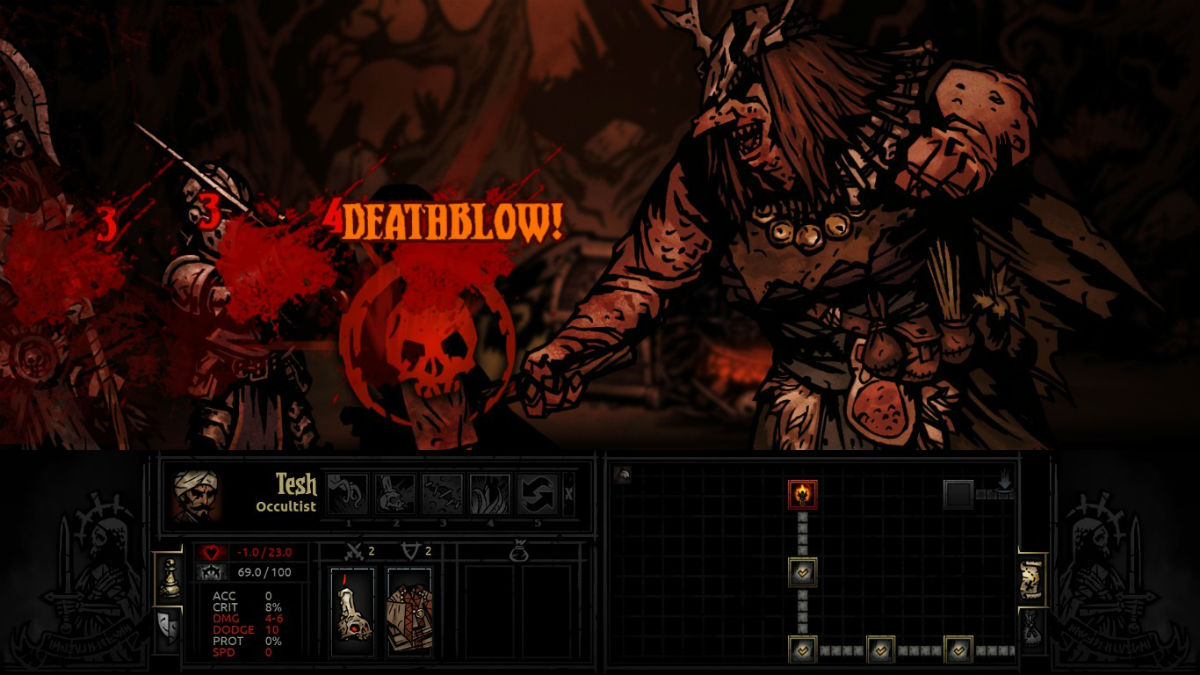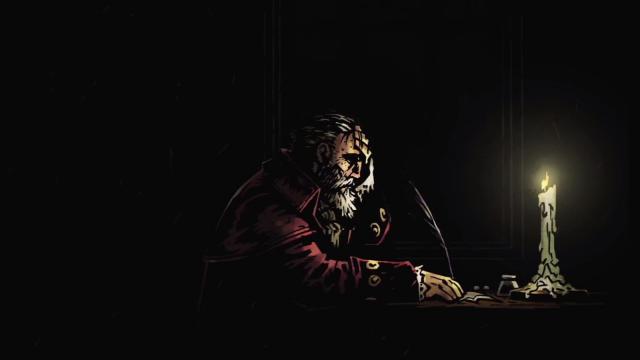Although the approach and execution is vastly different in Darkest Dungeon than your typical 2D RPG, the heart of the game is still in turn-based battles. They swing at you, you swing back at them, and hopefully at the end you come out with your whole team still standing.
Of course, half that team might be a gibbering mess, chanting insane words of arcane power while stealing the party’s loot, but that’s the appeal of this crowd-funded gem: overcome extreme adversity with a group of heroes who aren’t likely to live long.
One important aspect of the game that is radically different from other titles in the genre: your heroes are completely expendable. Yes, it hurts to have that Crusader raised to level 4 resolve across a dozen quests bleed out in combat or die of starvation. The good news is that afterward five more holy warriors probably just arrived through the stage coach and are ready to face death in his place.
 Strategy and luck will be needed in your war against the swine and worse terrors…
Strategy and luck will be needed in your war against the swine and worse terrors…
Your party members simply will die, and with some regularity, but following this combat guide will keep them alive a bit longer so you can complete more quests and inch your way towards the final dungeons.
Before (or after) going through our combat guide, you may also want to take a look at our other guides full of tips and tricks:
- Darkest Dungeon beginner’s strategy guide
- Darkest Dungeon hero class guide
- Darkest Dungeon party combos guide
- Darkest Dungeon curios guide
- Darkest Dungeon mods you need to install
Darkest Dungeon Hero Positions
There are plenty of different party combos to be utilized, and each is useful in different situations. In general, you want a good balance between dealing straight damage and either managing the enemy or dealing with setbacks in your own party. Since healing only occurs while camping or in battle, a means of lowering stress and reducing damage within your party is key to staying alive, especially during longer quests.
The preferred position for each class is critical to take note of, since that’s where the hero’s best attacks will work, but remember that they aren’t set in stone. It’s always a good idea to invest in those skills that can be used from other positions, as your carefully crafted lineup will frequently be rearranged in surprise rounds.
Many of the monstrous creatures found in Darkest Dungeon have one or more abilities that also force characters to move forward or backwards in the formation. Rather than wasting turns having to rearrange your party, its a better idea to be able to attack or use helpful effects from any position with a backup skill.
The Crusader’s Holy Lance ability, for instance, is generally of no use, since it means you’ll be giving up the ability to use either Smite or Holy Accusation. When you find the Crusader randomly in the back row at the start of a surprise combat however, Holy Lance not only lets you deal some damage, but it moves the Crusader back towards the front where he belongs.
Enemy position is equally important, since attacks can only hit specific slots on the enemy side. Before landing that death blow, always think about how you are going to deal with the corpse that gets left behind, as it can get in the way and prevent you from hitting the next enemy.
Corpse removal skills are helpful to have on hand, and it can also be extremely useful to turn the tables on the opposing side and mess with their formation. The Daemon’s Pull skill from the Occultist is a good choice on that front, letting you pull a protected enemy in the back row straight to the front, where it will be vulnerable to your front line bruisers.
 Your formation will frequently be broken by attacks like these.
Your formation will frequently be broken by attacks like these.
Darkest Dungeon Torch Levels
The light level, controlled primarily by using up torches bought during the provisioning phase, has a huge impact on your experience on any quest.
To save money, it’s actually a perfectly viable strategy to simply ignore torches altogether and go adventuring completely in the dark. You will take much more stress damage at the 0 light level, but it frees up your inventory slots, results in better loot finds, and ensures you’ll score critical hits more often, which more than makes up for it.
If you don’t want total darkness but still don’t want to spend money on torches, there are several skills available that bump the light level up slightly, especially from the Vestal and Crusader.
 Bonus critical hits can make up for all the other downsides.
Bonus critical hits can make up for all the other downsides.
The main downsides to adventuring in darkness are that you won’t scout as often – making it difficult to find a boss during a long quest – and you won’t surprise the enemy nearly as frequently.
That extra stress damage in low light conditions can also get crazy, and having a group of characters who all ignore your commands or pass their turn due to stress afflictions make this already hard game insanely frustrating. If you don’t want to add that extra concern, be sure to stock up on torches (usually around 6-8 to stay at highest light levels in a short quest).
Darkest Dungeon Stress Relief
There’s no way around it: your party is going to end up with high stress during the course of a quest, and it’s very likely someone is going to get a new affliction when hitting 100 stress. That doesn’t mean they all have to all become afflicted or you can’t stave off heart attacks when nearing the 200 mark, though, as there are effective ways of keeping stress down (for awhile at least).
High stress has a serious cascade effect: a character who hits 100 stress and gains an affliction like abusive, paranoid, hopeless, etc. will rant during combat and deal stress damage to surrounding party members at random times during battle. Essentially, you want to stop anyone from hitting the highest stress levels, even if everyone ends up hovering just below a resolve test.
 You want to avoid this for as long as possible.
You want to avoid this for as long as possible.
Normally, a less useful hero than many other classes, the Jester can lower stress by 10 at a time with the Inspiring Tune skill during battle, and that number goes up as the Jester’s resolve increases and you upgrade the skill. While the Hound Master’s Cry Havoc skill offers a smaller amount of stress healing, it does affect the whole group at once, making it useful when everyone has been taking stress damage.
Several classes have the ability to manage their own stress if you feel comfortable swapping out an attack skill. The Crusader’s Inspiring Cry ability offers a decent amount of stress reduction on himself if you spend the gold to actually upgrade the skill. The Leper’s Withstand ability also works very well on that front, as it not only reduces stress, but also increases the Protection skill so you take less health damage the rest of the battle.
Darkest Dungeon Combat Healing
The inability to heal outside of camping or combat – and the lack of healing potions – makes combat incredibly deadly, especially as you venture further. Just like with stress relief, you always want to have a dedicated character who can heal others, or several characters who can heal themselves.
Just like with attack skills, keep in mind that healing capabilities change in different lineup positions – the Occultist, for instance, can be a better healer than the Vestal using Wyrd Reconstruction from the back row or third slot.
Since combat is where the bulk of your healing will occur, an excellent strategy when you are low on health is to kill all but one enemy and make sure the last monster standing has a low stun resistance. Keep him stunned for a round or two so you can spend some time healing, but don’t keep this going too long, as its very easy for the tide to unexpectedly turn in this game, even when you seemingly have the upper hand.
Dealing Damage And Controlling The Enemy
Stunning is great, but outright killing is better. In the opening round of combat however, a volley of stunning (assuming your enemies don’t have high stun resistance) from a skill like the Plague Doctor’s Blinding Gas skill can be helpful. There’s a balance to be struck here though – don’t waste time trying to stun an opponent you could be killing instead.
 A dead enemy is a manageable enemy – corpses don’t hit back!
A dead enemy is a manageable enemy – corpses don’t hit back!
Deciding who to target first and how to spread out your damage is a crucial part of making it through combat without injured and insane party members. Always think big picture and not just the next round, but make sure you are taking out the enemies most likely to increase your stress.
The Madman enemy for instance won’t be dealing much damage, but both of his abilities cause stress and then increase future stress damage on that character. If the combat goes on for more than a few rounds, he has the potential to cause afflictions on your whole party. Killing him first should generally be the priority of anyone in your group capable of hitting the back row.
Just as important is to always pay careful attention to the turn order. Since healing is so scarce, always focus on the enemy who hasn’t had his turn yet, if you have the possibility to kill him before the next round. It’s in your best interest to take monsters down quickly and have combat remain as short as possible.
Accepting Defeat
When everything goes to hell and you are on the verge of losing your entire party in the next combat, remember that you can abandon the quest! It stings, but it’s better than an avoidable total party wipe and having to start over with lower level heroes again.
Yes, you will take extra stress damage, and you won’t get the quest rewards, but you will come away with whatever loot you discovered before giving up and have the chance to put your half-mad party up in the Abbey or Tavern for a week.
 Might as well accept the inevitability of death now.
Might as well accept the inevitability of death now.
Got any great Darkest Dungeon combat tips? Let us know how you’ve managed to slay all those eldritch abominations while keeping your party healthy and whole!







Published: Feb 8, 2016 01:20 pm